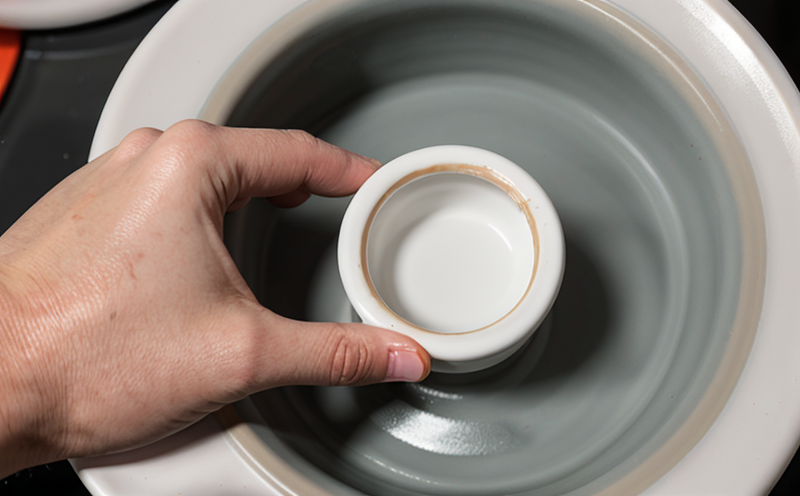ISO 23145 Creep Resistance of High Temperature Nanoceramics
The ISO 23145 standard is a critical tool for the testing and evaluation of creep resistance in high-temperature nanoceramics. Creep resistance, or the ability to withstand deformation under sustained mechanical stress at elevated temperatures, is essential for materials used in aerospace, energy, and other demanding sectors where performance must be maintained over extended periods.
The test method specified by ISO 23145 involves subjecting specimens of nanoceramics to a combination of tensile stress and temperature conditions that simulate real-world operational scenarios. This process helps determine the material's resistance to creep, which is particularly important for materials used in high-temperature applications such as turbine blades, exhaust systems, and structural components.
Specimen preparation for this test requires precise procedures to ensure accurate results. The nanoceramic samples are typically prepared using advanced techniques that include mechanical grinding, polishing, or electrochemical deposition methods. The specimens must be uniform in size and shape to avoid biasing the creep testing results.
The instrumentation used during the ISO 23145 test includes specialized high-temperature furnaces capable of maintaining precise temperature settings within narrow tolerances. Strain measurement is performed using strain gauges or displacement sensors that are calibrated to detect even minute changes in specimen dimensions under stress. The test setup allows for continuous monitoring of both temperature and mechanical deformation, providing real-time data on the creep behavior of nanoceramics.
Acceptance criteria for this test are based on predefined limits for allowable strain rates at specified temperatures. Compliance with these standards ensures that materials meet the required performance specifications under high-temperature conditions. The results of ISO 23145 tests provide valuable insights into a material's suitability for use in demanding environments, contributing to improved design and reliability.
This test method is particularly relevant for industries such as aerospace, where the integrity of components operating at extreme temperatures must be guaranteed. By adhering to international standards like ISO 23145, manufacturers can ensure that their products meet stringent quality requirements and perform reliably over extended service lives.
The process begins with careful selection of nanoceramic samples followed by meticulous preparation using advanced techniques to achieve uniformity in the specimens. The testing apparatus must be capable of maintaining precise temperature control within tight tolerances, along with accurate strain measurement systems. Continuous monitoring during the test ensures real-time data collection and analysis.
Understanding creep resistance is crucial for engineers designing components that will operate at elevated temperatures. By leveraging ISO 23145, quality managers can ensure that nanoceramics used in their products meet stringent performance criteria. This standard provides a robust framework for assessing material behavior under stress and temperature conditions, contributing to the development of safer and more reliable products.
In summary, the ISO 23145 test is an indispensable tool for evaluating creep resistance in high-temperature nanoceramics. Its application ensures that materials used in critical applications meet stringent performance standards, enhancing reliability and safety in demanding environments.
Industry Applications
- Aerospace: Turbine blades, exhaust systems
- Energy Sector: Power generation components, fuel cell structures
- Motorsport: Engine parts for high-performance engines
- Defense: Structural materials for missile and aircraft components
- Automotive: Exhaust manifolds, turbocharger components
- Chemical Processing: Reactor linings, heat exchanger internals
- Manufacturing Equipment: High-temperature processing tools
The ISO 23145 test is widely used across various sectors to ensure the durability and reliability of nanoceramics under high-temperature conditions. This testing method helps in identifying materials that can withstand prolonged exposure to elevated temperatures without significant deformation, making it essential for applications where performance must be maintained over extended periods.
Why Choose This Test
- Precise measurement of creep behavior under high-temperature conditions
- Compliance with international standards ensuring reliability and consistency
- Advanced instrumentation for accurate data collection
- Real-world simulation of operational scenarios enhancing applicability
- Supports the development and quality assurance of nanoceramic components
- Aids in meeting regulatory requirements for high-temperature applications
- Facilitates innovation through detailed insights into material performance
- Enhances product reliability and safety ensuring longevity in demanding environments
The ISO 23145 creep resistance test is chosen by quality managers, compliance officers, and R&D engineers for its ability to provide accurate and reliable data on the behavior of nanoceramics under high-temperature conditions. This ensures that materials used in critical applications meet stringent performance criteria, enhancing reliability and safety.
Environmental and Sustainability Contributions
The ISO 23145 creep resistance test plays a vital role in promoting sustainability by ensuring the durability and efficiency of nanoceramic components. By identifying materials capable of withstanding high-temperature conditions, this testing method supports the design and development of more efficient energy systems, reducing waste and resource consumption.
Through precise measurement of creep behavior under stress, ISO 23145 helps in minimizing material failures, which can lead to significant reductions in operational downtime. This translates into lower maintenance costs and increased productivity, contributing positively to environmental sustainability by optimizing resource use.
The test's ability to enhance product reliability also leads to safer operations, reducing the likelihood of accidents or incidents that could result in environmental damage. By ensuring high-performance materials are used in critical applications, ISO 23145 supports a more sustainable future where resources are used efficiently and effectively.





